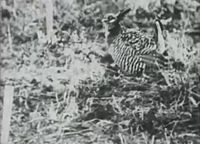Heath Hen
 From Conservapedia
From Conservapedia | Heath hen | |
|---|---|

| |
| Scientific classification | |
| Kingdom Information | |
| Domain | Eukaryota |
| Kingdom | Animalia |
| Branch | Deuterostomia |
| Phylum Information | |
| Phylum | Chordata |
| Sub-phylum | Vertebrata |
| Infraphylum | Gnathostomata |
| Class Information | |
| Superclass | Tetrapoda |
| Class | Aves |
| Order Information | |
| Superorder | Galloanserimorphae |
| Order | Galliformes |
| Sub-order | Phasiani |
| Family Information | |
| Superfamily | Phasianoidea |
| Family | Phasianidae |
| Genus Information | |
| Genus | Tympanuchus |
| Species Information | |
| Species | T. cupido |
| Subspecies | T. c. cupido |
| Population statistics | |
| Conservation status | Extinct |
The heath hen (Tympanuchus cupido cupido) was a subspecies of the greater prairie chicken, and may have been the bird - and not the wild turkey - that was served during the first Thanksgiving dinner by the early American colonists. Once found in the grassy areas of the east coast of the United States, the heath hen became extinct by 1932, the result of over-hunting and human development.
Description[edit]
The heath hen was similar to the greater prairie chicken, albeit smaller. It was about 17 inches long and weigh 24-42 ounces. The color overall was a buff brown with a reddish hue, with heavier dark barring on the feathers as opposed to prairie chickens. Males have long feathers on either side of the head which, when raised in display during the breeding season, give the appearance of having "ears"; males further display an inflatable orange-colored sack on either side of the neck, which they use to amplify their breeding calls.
Extinction[edit]
Locally abundant, the heath hen's range coincided with the developing American colonies; they were a cheap, easily accessible food source. But by the time of the American Revolution, it was noticed that the bird was getting scarce. In 1830 even the great naturalist John James Audubon stated the birds were rare.[1] Over-hunting had taken its toll.
The last sanctuary for the heath hen after the 1870s was the island of Martha's Vineyard, off Cape Cod. Fifty of the birds were left alive by 1907, and there was a glimmer of hope when the population seemed to rebound to over 2,000 by 1915. In 1916, however, a wildfire burned away much of its breeding ground; the next winter was bad, and was followed by an influx of goshawks and a poultry disease, reducing the number to an unsustainable level. In 1918 a film was commissioned by the State of Massachusetts in an effort to draw public awareness to the vanishing bird,[2] and ironically became the only filmed record of the heath hen.
By 1927 there were thirteen birds left, with eleven of them male. Within five years they had dwindled down to one, a male named "Booming Ben", and he was last seen alive on March 11, 1932.[3]
The heath hen is also the subject of a "de-extinction" program, along with other animals such as the woolly mammoth and passenger pigeon; the hope is that the species could be revived via DNA experimentation.[4][5]
References[edit]
- ↑ http://www.audubon.org/birds-of-america/pinnated-grouse
- ↑ https://www.bostonglobe.com/metro/2014/03/07/long-extinct-heath-hen-comes-life-archival-film/X9zKEdB6dvH71Pt6rB2tFL/story.html
- ↑ http://daily.jstor.org/last-heath-hen/
- ↑ https://vineyardgazette.com/news/2014/04/03/never-say-never-heath-hen-may-get-its-boom-back
- ↑ http://breakthroughs.kera.org/bringing-back-the-heath-hen/
Categories: [Birds] [Grouse] [Extinct Birds]
↧ Download as ZWI file | Last modified: 02/10/2023 00:23:28 | 12 views
☰ Source: https://www.conservapedia.com/Heath_hen | License: CC BY-SA 3.0
 ZWI signed:
ZWI signed: KSF
KSF